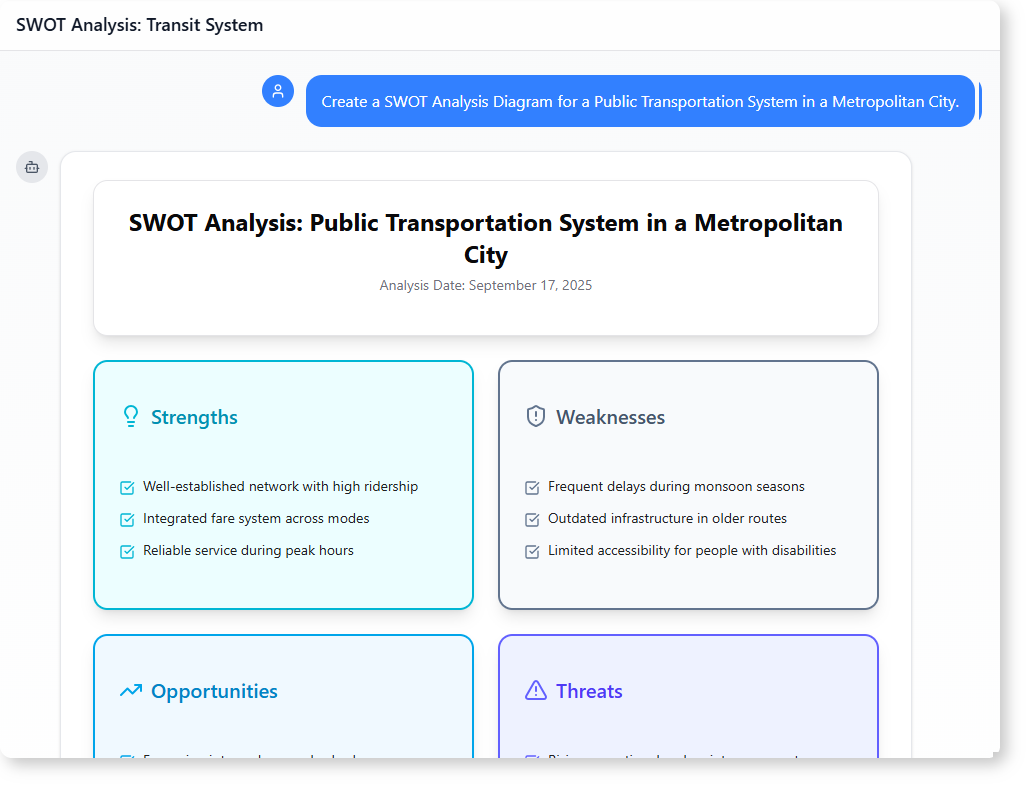Now Reading: How AI-Powered Modeling Software Creates a Smart SWOT Analysis for Public Transportation
-
01
How AI-Powered Modeling Software Creates a Smart SWOT Analysis for Public Transportation
How AI-Powered Modeling Software Creates a Smart SWOT Analysis for Public Transportation
How an AI-Powered Modeling Software Builds a Professional SWOT for Public Transit
Imagine a city planner trying to improve public transportation. They need to understand the system’s strengths and weaknesses, spot new opportunities, and plan for future threats. They don’t have time to manually create a SWOT diagram or write a full report.
Instead, they use a simple prompt to get a clear, structured SWOT analysis — complete with insights and a professional report.
This is exactly what happens when you use AI-powered modeling software. It doesn’t just generate diagrams — it helps you turn ideas into actionable intelligence.

The Planner’s Journey: From Prompt to Report
The user is a transportation policy analyst working for a metropolitan city. Their team is reviewing the current performance of the public transit network and preparing a strategy for the next five years.
They need a clear SWOT analysis to present to city leadership. Writing this manually would take hours, and the result might miss key factors.
So they start with a single prompt:
Create a SWOT Analysis Diagram for a Public Transportation System in a Metropolitan City.
The AI-powered modeling software responds instantly with a well-organized SWOT diagram, clearly separating strengths, weaknesses, opportunities, and threats.
The diagram includes real-world factors relevant to a large urban system:
- Strengths: Well-established network with high ridership, integrated fare system, reliable service during peak hours
- Weaknesses: Frequent delays during monsoon seasons, outdated infrastructure in older routes, limited accessibility for people with disabilities
- Opportunities: Expansion into underserved suburban areas, introduction of electric and autonomous buses, partnerships with tech firms for real-time tracking
- Threats: Rising operational and maintenance costs, urban development projects disrupting routes, competition from ride-sharing and car services
After reviewing the diagram, the analyst asks a follow-up question:
Turn this diagram into a professional report with clear sections, including an introduction, analysis, and conclusion.
The AI modeling tool generates a full report structured for presentation. It includes:
- A concise introduction explaining the purpose of the SWOT
- A detailed analysis of each category, with context and real-world implications
- A clear conclusion that highlights key risks and recommendations
The output is not just a list — it’s a thoughtful, readable document that mirrors how a professional would write it.
Why This Matters for Urban Planning
Traditional SWOT tools are static and require manual effort. The AI-powered modeling software changes that by automating the structure and insight.
It doesn’t just generate a diagram. It interprets common challenges in public transportation — like seasonal delays or infrastructure aging — and presents them in a way that decision-makers can act on.
This kind of AI modeling tool is especially useful for:
- City planners assessing system performance
- Transport agencies identifying growth opportunities
- Stakeholders needing fast, accurate summaries
Unlike generic tools, this AI-powered modeling software understands the context of public transportation. It doesn’t just list points — it connects them to real issues like accessibility, cost, and service reliability.
The Power of AI Modeling in Strategy Development
This example shows how AI modeling can support strategic thinking.
When a planner says, ‘I need to understand the system better,’ the AI doesn’t just respond with a diagram.
It delivers a structured, insightful, and practical analysis — turning a simple request into a strategic asset.
The ability to generate a SWOT diagram software output that’s both accurate and meaningful makes this a valuable tool in transportation planning.
It’s not about replacing human judgment. It’s about helping humans see patterns, test assumptions, and explore options faster.
How It Helps in Real-World Scenarios
Consider a metropolitan city planning to expand transit to a new suburb. A SWOT analysis helps answer:
- What’s working well in the current system?
- What’s holding it back?
- What new services could help?
- What risks might emerge?
With the AI-powered modeling software, these questions are answered in minutes — not days.
This is especially helpful when teams are under pressure to deliver results quickly.
FAQs
Q: Can AI modeling tools generate a SWOT diagram for a transportation system?
A: Yes. With a clear prompt like ‘Create a SWOT Analysis for a Public Transportation System in a Metropolitan City,’ the AI-powered modeling software generates a detailed, context-aware SWOT diagram.
Q: Is the AI modeling tool capable of turning a SWOT diagram into a report?
A: Yes. After reviewing the diagram, a follow-up request like ‘Turn this into a professional report with clear sections’ produces a well-structured report with an introduction, analysis, and conclusion — ideal for presentations or internal reviews.
Q: Does this tool support SWOT report generation?
A: Absolutely. The AI modeling tool is designed to go beyond diagrams. It can generate a full SWOT report generator output that includes clear explanations, context, and strategic insight.
Q: How does this AI modeling tool handle real-world challenges in transit?
A: It analyzes common issues like seasonal delays, infrastructure aging, and competition from ride-sharing. The generated content reflects realistic conditions faced in metropolitan cities, making it practical for planners.
Ready to map out your system’s interactions? Give our AI-powered modeling software a try at Visual Paradigm’s AI Chatbot today!
